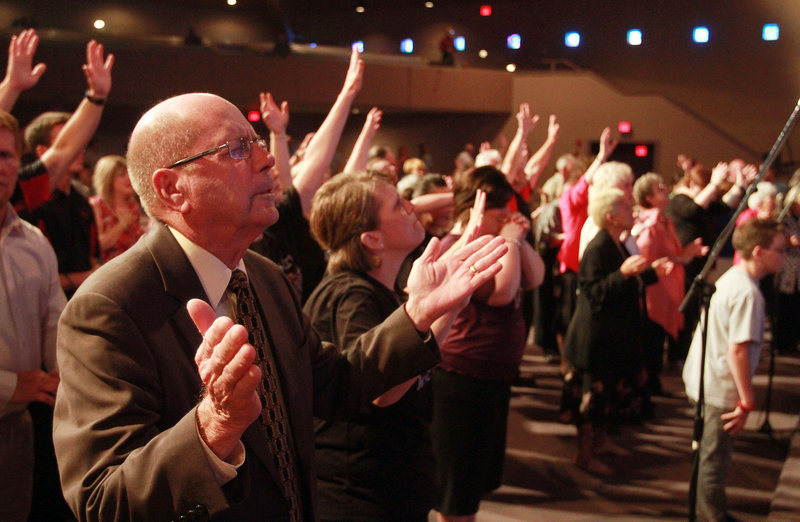PENSACOLA, Fla. — For years starting in the mid-1990s, millions from around the globe visited a humble church in Florida’s Panhandle for lively Pentecostal revival services where believers flocked on stage to be healed by God for cancer, addiction and broken hearts.
At its height, the Brownsville Revival drew as many as 5,500 people a night for six years; estimates put the total between 2.5 million and 4.5 million people. Donations poured in as the Brownsville Assembly of God added staff, built a massive new sanctuary and opened a school for preachers.
In the decade after being the home of the largest Pentecostal outpouring in U.S. history, the church has been on the edge of financial ruin. It racked up $11.5 million in debt, to be paid after the out-of-town throngs and its former pastor moved on.
“Every Monday I find out what the (Sunday) offering was and we decide what we can pay this week,” said the Rev. Evon Horton, Brownsville’s current pastor. “The good news is last week we paid our mortgage. The bad news is it drained our bank accounts.”
The paid staff is down to six from around 50, and the newsletter is printed monthly instead of weekly. A total of about 800 to 1,000 worshippers attend two Sunday services, but most pews go empty in the 2,200-seat sanctuary. Another 2,600-seat sanctuary built just for the revival is used for a gym, community classes and storage.
The church has trimmed millions off its debt by selling property and slashing expenses, and it’s raising money to pay off the remaining $6.5 million.
Horton said it’s a wonder — a blessing from God, really — that the church has survived so long.
“It’s the hardest thing I’ve ever dealt with in 30 years of ministry,” he said.
Almost three years after the revival trickled down to its last nightly service in 2001, the longtime former pastor, the Rev. John Kilpatrick, moved on. He now runs a bustling church and traveling revival ministry based in Daphne, Ala.
Kilpatrick said Brownsville was never the wealthy church many assumed during the revival years, so loans were the only way to pay for growth. He said the church fell deeper into debt after he departed and membership dropped.
“I never would have left if I knew the struggles it was going to have,” he said.
A lot has changed since the revival’s beginning on Father’s Day 1995. Ken Griffin, who first came to the church 36 years ago as a surfer and is now a board member, still marvels at what happened that day. Kilpatrick brought in visiting evangelist Steve Hill and something stirred.
“He just asked a simple question, like ‘If anyone really wants to get refreshed and get closer to God, then come up to the altar,’” Griffin said. “As he started praying for people, all kinds of things started happening. People were just getting ministered to, and the next thing we know it’s 4 o’clock in the afternoon.”
Word spread of people being miraculously healed and converted, and revival services were soon held four and five nights a week. The church began buying up nearby houses and razing them for parking, Horton said. It took in millions in donations and revenue from items like music CDs, but the church used mortgages to expand rather than cash.
“You’d think that money was just flowing into the place,” Kilpatrick said. “But it wasn’t.”
The Pensacola News-Journal raised questions at the time about the revival’s finances.
Horton said he’s still unsure what happened to all the money, but he’s concentrating on the future. “What good would it do me?” he asked.
Kilpatrick is trying to grow his current ministry. In a February talk posted on his church’s website, Kilpatrick asked for extra money to pay a $9,000 deficit from a recent revival in Orlando; to purchase a second TV production truck for $250,000; and to help the church pay its bills. He also lamented the cost of maintaining two homes near the Alabama coast, which tax records show are worth about $1 million total.
The Pensacola church is trying to raise about $7 million by getting people to give $1,000 each for debt relief.
“We can be debt-free if just 7,000 of the millions of people who attended the revival help out,” Horton said.
Robert Helms Jr., a church volunteer and retired Navy aviator, said the church is trying to move ahead without bitterness.
He directs a community center in the old overflow sanctuary, where pews now hold old lamps destined for Habitat for Humanity homes. They offer day care, GED classes, youth basketball games, women’s self-defense and computer training for the neighborhood.
Send questions/comments to the editors.



Success. Please wait for the page to reload. If the page does not reload within 5 seconds, please refresh the page.
Enter your email and password to access comments.
Hi, to comment on stories you must . This profile is in addition to your subscription and website login.
Already have a commenting profile? .
Invalid username/password.
Please check your email to confirm and complete your registration.
Only subscribers are eligible to post comments. Please subscribe or login first for digital access. Here’s why.
Use the form below to reset your password. When you've submitted your account email, we will send an email with a reset code.